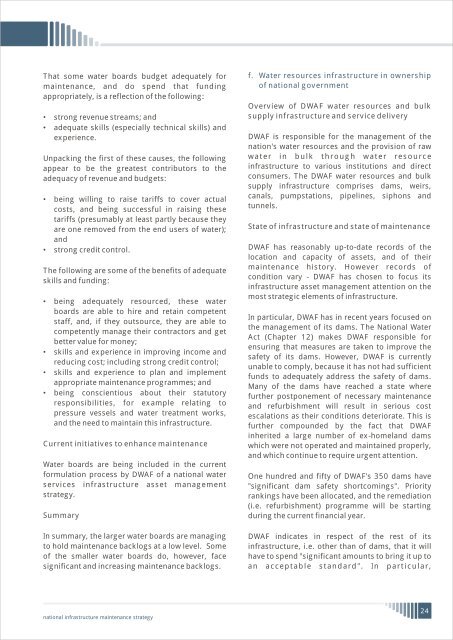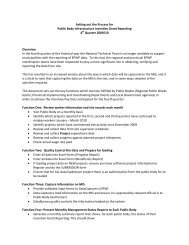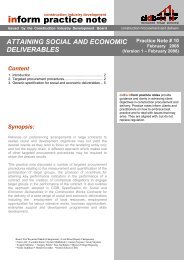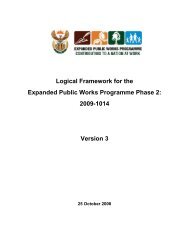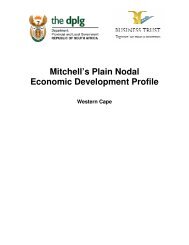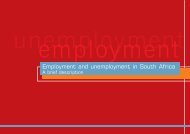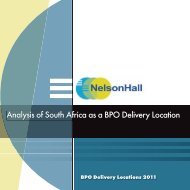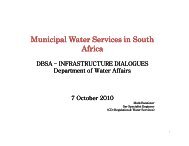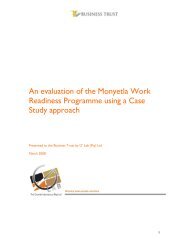National Infrastructure Maintenance Strategy - Construction Industry ...
National Infrastructure Maintenance Strategy - Construction Industry ...
National Infrastructure Maintenance Strategy - Construction Industry ...
You also want an ePaper? Increase the reach of your titles
YUMPU automatically turns print PDFs into web optimized ePapers that Google loves.
That some water boards budget adequately for<br />
maintenance, and do spend that funding<br />
appropriately, is a reflection of the following:<br />
• strong revenue streams; and<br />
• adequate skills (especially technical skills) and<br />
experience.<br />
Unpacking the first of these causes, the following<br />
appear to be the greatest contributors to the<br />
adequacy of revenue and budgets:<br />
• being willing to raise tariffs to cover actual<br />
costs, and being successful in raising these<br />
tariffs (presumably at least partly because they<br />
are one removed from the end users of water);<br />
and<br />
• strong credit control.<br />
The following are some of the benefits of adequate<br />
skills and funding:<br />
• being adequately resourced, these water<br />
boards are able to hire and retain competent<br />
staff, and, if they outsource, they are able to<br />
competently manage their contractors and get<br />
better value for money;<br />
• skills and experience in improving income and<br />
reducing cost; including strong credit control;<br />
• skills and experience to plan and implement<br />
appropriate maintenance programmes; and<br />
• being conscientious about their statutory<br />
responsibilities, for example relating to<br />
pressure vessels and water treatment works,<br />
and the need to maintain this infrastructure.<br />
Current initiatives to enhance maintenance<br />
Water boards are being included in the current<br />
formulation process by DWAF of a national water<br />
services infrastructure asset management<br />
strategy.<br />
Summary<br />
In summary, the larger water boards are managing<br />
to hold maintenance backlogs at a low level. Some<br />
of the smaller water boards do, however, face<br />
significant and increasing maintenance backlogs.<br />
f. Water resources infrastructure in ownership<br />
of national government<br />
Overview of DWAF water resources and bulk<br />
supply infrastructure and service delivery<br />
DWAF is responsible for the management of the<br />
nation's water resources and the provision of raw<br />
water in bulk through water resource<br />
infrastructure to various institutions and direct<br />
consumers. The DWAF water resources and bulk<br />
supply infrastructure comprises dams, weirs,<br />
canals, pumpstations, pipelines, siphons and<br />
tunnels.<br />
State of infrastructure and state of maintenance<br />
DWAF has reasonably up-to-date records of the<br />
location and capacity of assets, and of their<br />
maintenance history. However records of<br />
condition vary - DWAF has chosen to focus its<br />
infrastructure asset management attention on the<br />
most strategic elements of infrastructure.<br />
In particular, DWAF has in recent years focused on<br />
the management of its dams. The <strong>National</strong> Water<br />
Act (Chapter 12) makes DWAF responsible for<br />
ensuring that measures are taken to improve the<br />
safety of its dams. However, DWAF is currently<br />
unable to comply, because it has not had sufficient<br />
funds to adequately address the safety of dams.<br />
Many of the dams have reached a state where<br />
further postponement of necessary maintenance<br />
and refurbishment will result in serious cost<br />
escalations as their conditions deteriorate. This is<br />
further compounded by the fact that DWAF<br />
inherited a large number of ex-homeland dams<br />
which were not operated and maintained properly,<br />
and which continue to require urgent attention.<br />
One hundred and fifty of DWAF's 350 dams have<br />
"significant dam safety shortcomings". Priority<br />
rankings have been allocated, and the remediation<br />
(i.e. refurbishment) programme will be starting<br />
during the current financial year.<br />
DWAF indicates in respect of the rest of its<br />
infrastructure, i.e. other than of dams, that it will<br />
have to spend "significant amounts to bring it up to<br />
an acceptable standard". In particular,<br />
national infrastructure maintenance strategy<br />
24


